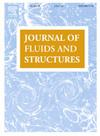两个类摆串联细长圆柱的振动特性研究
IF 3.5
2区 工程技术
Q1 ENGINEERING, MECHANICAL
引用次数: 0
摘要
本实验研究了两个相同的细长串列圆柱体在风洞中横流作用下的流-结构相互作用。上游和下游圆柱体安装在摆状结构中,只允许具有匹配的固有频率的横向振荡,并且还在固定配置中进行了测试以进行比较。所有的实验都在2.0到7.5的间距比范围内进行,雷诺数范围为16000到22000。使用高速摄像机记录横向位移,并使用粒子图像测速仪(PIV)分析流动结构。主要目的是从PIV结果中观察到的流动动力学与气缸的振荡行为相关联。结果表明,在不同的间距比下,振荡现象都有发生,当间距比为2.0时振荡现象最显著,当间距比为3.5时振荡特征明显,且振幅极值。振动响应的离散小波变换相互关联表明,下游圆柱的振动受到上游圆柱尾迹的影响,其幅值仍被上游圆柱尾迹包裹。驱动振荡行为的流动结构表明,除了L/D=3.5的情况外,气缸的振动主要由尾迹引起的振动控制,在这种情况下观察到类似飞奔的不稳定性,这是一种以前没有报道过的机制。本文所描述的现象为能量收集应用提供了潜在的机会。本文章由计算机程序翻译,如有差异,请以英文原文为准。
On the oscillatory behavior of two pendulum-like tandem circular slender cylinders
This experimental study investigates the flow–structure interaction of two identical tandem slender cylinders subjected to cross-flow in a wind tunnel. The upstream and downstream cylinders were mounted in a pendulum-like configuration, allowing only transverse oscillation with matching natural frequencies, and were also tested in a fixed configuration for comparison purposes. All experiments were performed at spacing ratios ranging from 2.0 to 7.5, within a Reynolds number range of 16,000 to 22,000. Lateral displacements were recorded using a high-speed camera, and flow structures were analyzed using Particle Image Velocimetry (PIV). The primary objective was to correlate the observed flow dynamics from the PIV results with the oscillatory behavior of the cylinders. The results show that oscillations occurred for all investigated spacing ratios, with the most significant oscillations observed at a spacing ratio of 2.0 and a distinctive pattern with extreme amplitudes at a spacing ratio of 3.5. Cross-correlation of the Discrete Wavelet Transform of the vibration response reveals that the vibration of the downstream cylinder are influenced by the wake of the upstream cylinder, with its amplitude remaining enveloped within the wake of the upstream cylinder. The flow structure driving the oscillatory behavior indicates that the vibrations of the cylinders are predominantly governed by wake-induced vibration, except for the case of , where a galloping-like instability was observed—a mechanism not previously reported for this configuration. The phenomenon described in this paper presents potential opportunity for energy harvesting applications.
求助全文
通过发布文献求助,成功后即可免费获取论文全文。
去求助
来源期刊

Journal of Fluids and Structures
工程技术-工程:机械
CiteScore
6.90
自引率
8.30%
发文量
173
审稿时长
65 days
期刊介绍:
The Journal of Fluids and Structures serves as a focal point and a forum for the exchange of ideas, for the many kinds of specialists and practitioners concerned with fluid–structure interactions and the dynamics of systems related thereto, in any field. One of its aims is to foster the cross–fertilization of ideas, methods and techniques in the various disciplines involved.
The journal publishes papers that present original and significant contributions on all aspects of the mechanical interactions between fluids and solids, regardless of scale.
 求助内容:
求助内容: 应助结果提醒方式:
应助结果提醒方式:


